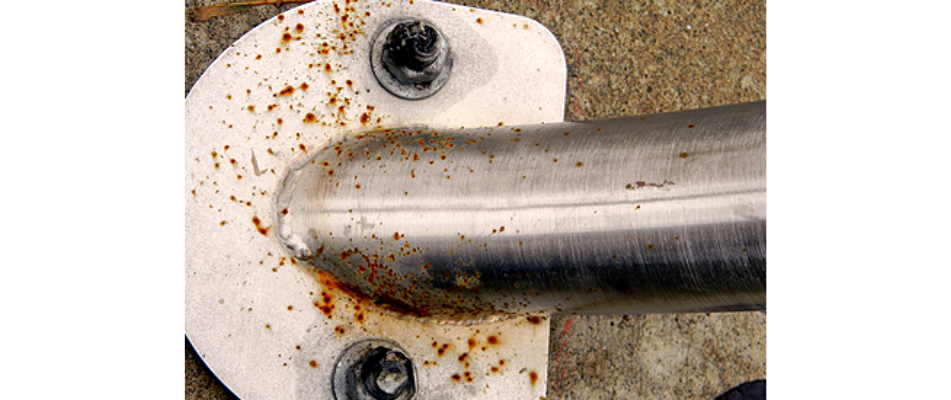What is Tea Staining & How Do I Remove It from My Stainless Steel Products?

It's a question that comes up more often than you might think: "I've noticed some brownish discolouration on my stainless steel. What is it and how can I get rid of it?" If you've ever wondered about this or have had this very issue, you're in the right place. In this article, we'll dive into the phenomenon known as "tea staining" on stainless steel and discuss effective methods to remove it.
What is Tea Staining?
Tea staining refers to the brownish discolouration that can sometimes appear on stainless steel surfaces, particularly in environments rich in saline, chlorides, or pollutants. Contrary to what its name might suggest, this has nothing to do with actual tea. Although tea staining looks unattractive, it’s not going to affect the structural integrity of the stainless steel – tea staining is simply a cosmetic issue.
Factors Contributing to Tea Staining:
- Exposure to saline or chloride-rich environments (e.g., coastal areas).
- Rougher surface finishes which trap contaminants.
- Contact with ferrous materials, leading to iron particle contamination.
- Accumulation of pollutants or airborne contaminants.
- Stagnant water or moisture retention.
How to Remove Tea Stains from Stainless Steel:
- Gentle Cleaning: Often, a simple cleaning solution made of warm water and a mild detergent is all you need. Use a soft cloth to apply the solution, scrubbing gently in the direction of the stainless steel's grain.
- Baking Soda Paste: For tougher stains, make a paste of baking soda and water. Apply this to the stain, and gently scrub with a soft cloth or brush, always moving in the direction of the grain.
- Specialised Cleaners: There are stainless steel cleaners available in the market that are designed to combat tea staining and other forms of discoloration. Always follow the manufacturer's instructions when using these products.
- Vinegar Solution: A solution of equal parts white vinegar and water can be effective. Apply the solution with a soft cloth, scrub gently, and then rinse thoroughly with clean water.
Prevention is Key
While the methods above can be effective in removing tea stains, prevention is always better than cure:
- Choose the right grade of stainless steel for your environment.
- Ensure a smooth finish and regular cleaning to prevent the accumulation of contaminants.
- Avoid contact with ferrous (iron) materials.
- If you're in a high-risk environment (like coastal areas), consider applying protective coatings or treatments to your stainless steel products.
Tea staining on stainless steel, while unsightly, is generally superficial and doesn't compromise the structural integrity of the material. By understanding its causes and following the preventive and cleaning measures mentioned, you can ensure that your stainless steel products remain as gleaming and impressive as the day you got them. Remember, with the right care, stainless steel can resist corrosion and retain its beauty for years to come.
If you need any other advice when it comes to your stainless steel products, get in touch with the team at www.astrastreetfurniture.com.au.

 Seating
Seating Benches
Benches  Curved Benches
Curved Benches Commercial Picnic Tables
Commercial Picnic Tables Concrete Plinth Mount Seating
Concrete Plinth Mount Seating Litter Bins
Litter Bins Bin Enclosures
Bin Enclosures  Shelters
Shelters Bike Parking
Bike Parking Architectural Bollards
Architectural Bollards Planter Boxes
Planter Boxes Skate Deterrents
Skate Deterrents  Drinking Fountains
Drinking Fountains Outdoor Classrooms
Outdoor Classrooms Aluminium Plank Furniture
Aluminium Plank Furniture Athens Suite
Athens Suite Barcelona Suite
Barcelona Suite Berlin Suite
Berlin Suite Copenhagen Suite
Copenhagen Suite Dublin Suite
Dublin Suite Florence Suite
Florence Suite Glasgow Suite
Glasgow Suite Liverpool Suite
Liverpool Suite London Suite
London Suite Madrid Suite
Madrid Suite Manchester Suite
Manchester Suite  Milan Suite
Milan Suite Orbit Suite
Orbit Suite Paris Suite
Paris Suite Prague Suite
Prague Suite  Portsmouth Suite
Portsmouth Suite Rome Suite
Rome Suite Venice Suite
Venice Suite  Vienna Suite
Vienna Suite Woodville Suite
Woodville Suite School Furniture
School Furniture Healthcare Furniture
Healthcare Furniture Local Government Furniture
Local Government Furniture Park & Street Furniture
Park & Street Furniture Shopping Centre Furniture
Shopping Centre Furniture Aged Care Furniture
Aged Care Furniture